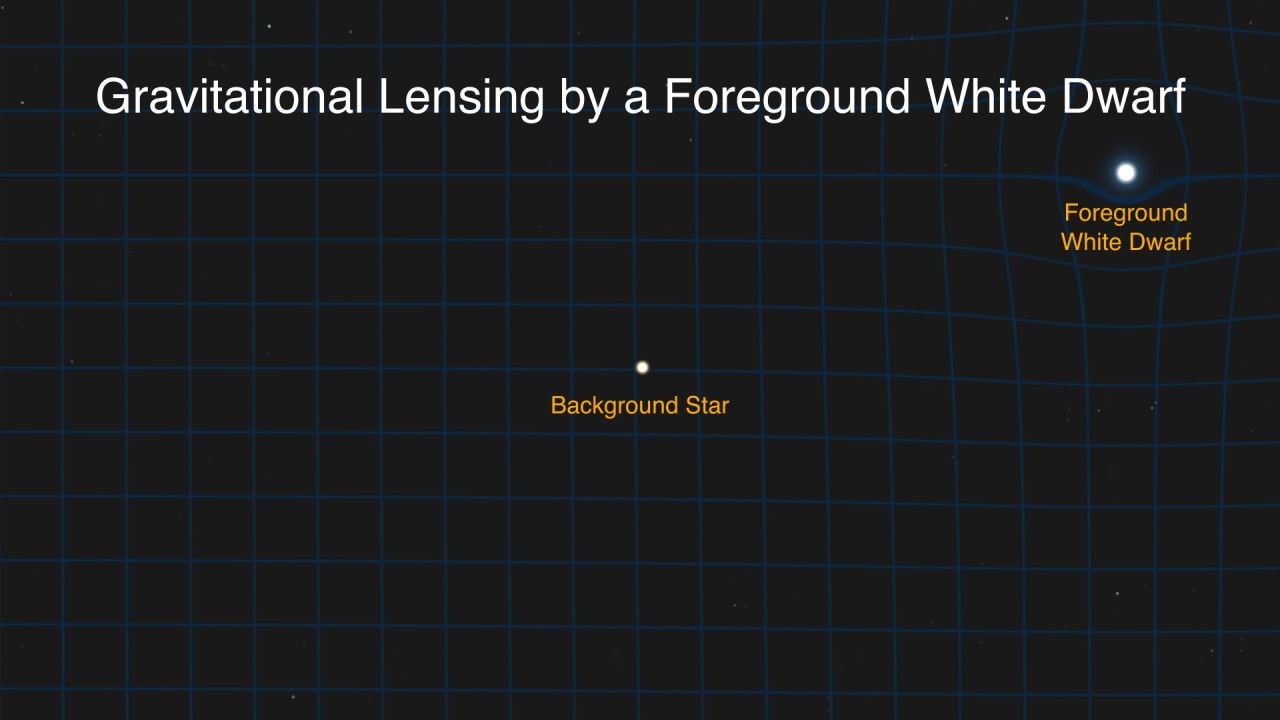1 min read
Hubble Measures Deflection of Starlight by a Foreground Object (Artist’s Illustration)

This artist's illustration shows how the gravity of a foreground white dwarf star warps space and bends the light of a distant star behind it. Astronomers using NASA's Hubble Space Telescope have for the first time directly measured the mass of a single, isolated white dwarf (the surviving core of a burned-out Sun-like star) – due to this optical trick of nature. The greater the temporary, infinitesimal deflection of the background star's image, the more massive the foreground star is. (This deviation is so small that it is equivalent to observing an ant crawl across the surface of a quarter from 1,500 miles away.) Researchers found that the dwarf is 56 percent the mass of our Sun.
This effect, called gravitational lensing was predicted as a consequence of Einstein's theory of general relativity from a century ago. Observations of a solar eclipse in 1919 provided the first experimental proof for general relativity. But Einstein didn't think the same experiment could be done for stars beyond our Sun because of the extraordinary precision required.
About the Object
- R.A. PositionR.A. PositionRight ascension – analogous to longitude – is one component of an object's position.11:45:42.9205
- Dec. PositionDec. PositionDeclination – analogous to latitude – is one component of an object's position.-64:50:29.459
- ConstellationConstellationOne of 88 recognized regions of the celestial sphere in which the object appears.Musca
- DistanceDistanceThe physical distance from Earth to the astronomical object. Distances within our solar system are usually measured in Astronomical Units (AU). Distances between stars are usually measured in light-years. Interstellar distances can also be measured in parsecs.About 15 light-years
About the Data
- Data DescriptionData DescriptionProposal: A description of the observations, their scientific justification, and the links to the data available in the science archive.
Science Team: The astronomers who planned the observations and analyzed the data. "PI" refers to the Principal Investigator.
- Object NameObject NameA name or catalog number that astronomers use to identify an astronomical object.LAWD 37 (LP 145-141)
- Object DescriptionObject DescriptionThe type of astronomical object.Isolated White Dwarf
- Release DateFebruary 2, 2023
- Science ReleaseFor the First Time Hubble Directly Measures Mass of a Lone White Dwarf
- CreditNASA, ESA, Ann Feild (STScI)
Related Images & Videos

Hubble Observations Used to Measure Mass of Lone White Dwarf Star LAWD 37
This graphic shows how microlensing was used to measure the mass of a white dwarf star. The dwarf, called LAWD 37, is a burned-out star in the center of this Hubble Space Telescope image. Though its nuclear fusion furnace has shut down, trapped heat is sizzling on the surface at...

Compass Image for White Dwarf Star LAWD 37
This graphic shows how microlensing was used to measure the mass of a white dwarf star. The dwarf, called LAWD 37, is a burned-out star in the center of this Hubble Space Telescope image. Though its nuclear fusion furnace has shut down, trapped heat is sizzling on the surface at...

Mass Determination of Single White Dwarf
This animation shows the motion of a white dwarf star passing in front of a distant background star. During the passage, the faraway star appears to change its position slightly, because its light path has been deflected by the white dwarf's gravity. Employing this trick of...
Share
Details
Claire Andreoli
NASA’s Goddard Space Flight Center
Greenbelt, Maryland
claire.andreoli@nasa.gov































